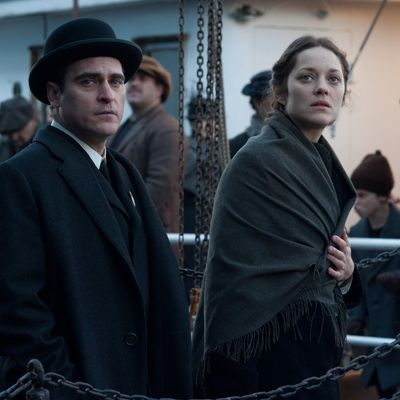
Writer-director James Gray creates male characters who are unable to control their emotions and suffer visibly, even floridly. That puts some viewers off, especially when — in movies like We Own the Night and Two Lovers — the camera loiters over Gray’s evident alter ego, Joaquin Phoenix, in Phoenix’s rage-and-snivel mode. Is Gray as self-indulgent as his protagonist? Oh, maybe. Sometimes. But few directors can sustain a mood so thick with melancholy and moral ambivalence. And Phoenix is, at best, a great actor, a holy fool who plunges into uncharted waters and prides himself on his flailing. They’re quite a pair.
Their latest collaboration is The Immigrant, set in New York circa 1921, but this time there’s an even more vivid presence than Phoenix. Marion Cotillard plays the title character, Eva, an obviously traumatized young Pole first seen waiting in line at Ellis Island with her coughing sister, Magda (Angela Sarafyan). The cough gets Magda quarantined, while Eva’s reputation for loose morals on the ship from Poland will likely lead to her deportation. The source of that rumor is a mystery for most of the film, but from how Eva quivers at its mention we know that something happened.
A lifeline of sorts arrives via Bruno Weiss (Phoenix), a Jew in an expensive suit who bribes a guard to spring Eva from custody and behaves, at first, like the courtliest gentleman. Who is this man, and what are his ulterior motives? It turns out that Bruno keeps a stable of immigrant women for sewing, performing at a racy Lower East Side vaudeville theater, and one other task (three guesses). He’s not a nice man, and Eva is sick over what she eventually has to do. But it looks to be the only way she can make enough to free her TB-ridden sister from the bowels of Ellis Island.
Well into The Immigrant, Gray introduces a third major character, a Houdini-esque magician named Emil (Jeremy Renner), who’s Bruno’s cousin and sometime antagonist. Emil is instantly smitten with Eva — he delivers, with a flourish, a white rose into her hand and wastes little time in planning to Take Her Away From All This. Is he as gallant and ingenuous as he appears? Or is his guileless persona his best trick?
With the aid of cinematographer Darius Khondji and production designer Happy Massee, Gray captures the look of sepia-toned period photographs (he must also have studied the Vito Corleone sections of The Godfather Part II), but the movie’s feel is modern, psychological. How could it not be with Phoenix so prominent? He doesn’t play Bruno as an obvious Fagin type — he’s too tortured. (This Jew has a big dose of Catholic guilt.) Bruno is an actor, too, and one whose feelings for Eva are starting to interfere with his shtick. It’s not an easy performance to watch — it’s messy. In the last scene, when Bruno gets a beating and his jaw swells up, Phoenix slips into Brando inflections from On the Waterfront and The Godfather, and I’m sure the imitation is unconscious. He’s using all his resources — one of them is his sense memory of watching the greatest of all Method actors. He’s lost in the moment.
Cotillard is more controlled, but her emotions are, if anything, more powerful. No matter how much Eva hardens her features (and heart), the mask keeps slipping. Eva isn’t an actress, a natural liar. Every bit of cunning costs her a piece of her humanity; her drive for self-preservation is at constant odds with her self-disgust. Although Eva is a devout Catholic, I can imagine the character evolving in an Ayn Rand direction, resentful of charity for others after what she was forced to endure. That I think so far beyond what happens onscreen is a testament to Cotillard, who transcends easy melodrama, who is not afraid to be harsh. She’s now the best leading film actress in the world.
The Immigrant has been the source of a semi-public battle between Gray and Harvey Weinstein, who reportedly pressed for cuts and allegedly threatened, as is his wont, to dump the film if he didn’t get his way. (Weinstein is a smart man, but doesn’t have much faith in his audience’s patience.) Gray stuck to his guns and the movie — a shade under two hours — has its longeurs, especially in the last, grueling act. But I didn’t see any scenes that could be shortened. On the contrary, the character of Emil seems truncated and, maybe as a result, far-fetched — he could use a little more screen time. And I wanted much more of an actress named Dagmara Dominczyk, who holds her own against Cotillard and then some as another of Bruno’s “girls” — one who’s seething with resentment at Eva’s tendency to hold herself above what she’s doing.
Weinstein’s problem with The Immigrant might just be that it doesn’t end on that upbeat, Oscar-bait note that marks so many of his prestige projects. The aura of hopelessness never dissipates. The final shot — a diptych in which each of the main characters moves toward into the fog, toward his or her own fate — offers no easy consolation. But the movie earns its dissonances. It’s richer than anything onscreen right now. It’s worth the pain.


